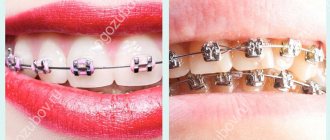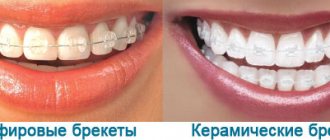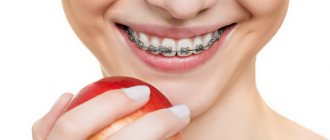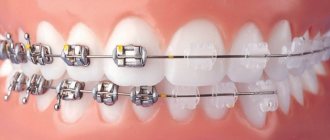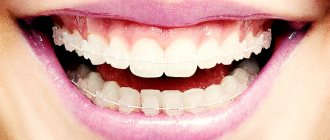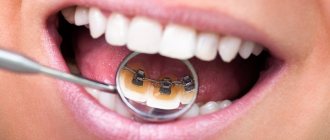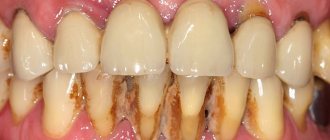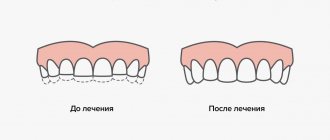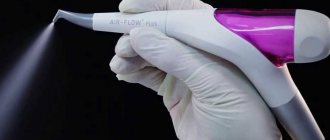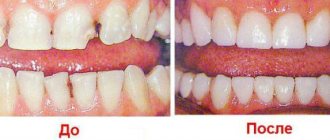Braces are special plates that are attached to the teeth to correct the bite. The plates are connected to each other by an arc, which, due to its elasticity, tends to take the correct position, puts pressure on the braces, and they, in turn, distribute the pressure on the teeth. Due to constant pressure, the bone tissue behind the tooth gradually decreases, the tooth moves to a new place and is fixed there. As a result, the bite becomes correct.
Most often, braces are installed in childhood, at 12–13 years old, when the jaw is still actively growing and more susceptible to changes. However, this does not mean that bite correction is only possible at this age - braces can also be installed on an adult. True, the treatment process in this case will have several features.
Indications for installing braces
As in childhood, in adulthood the only indication for installing braces is malocclusion. This anomaly is characterized by the following symptoms:
- Noticeable crowding of teeth, their creeping onto each other.
- Gaps between teeth.
- Teeth tilted back or forward.
- Excessive protrusion of one of the jaws forward or backward.
- Large distance between the teeth of the upper and lower jaw.
- Shift of the jaws or dentition laterally relative to each other.
These problems can be either noticeable even to the naked eye or hidden. Sometimes, at first glance, it seems to a person that everything is fine with his bite, although in fact there is a violation. In this case, only a dentist can recognize them during a professional examination.
What are the benefits of early treatment?
When correcting a bite, in most cases the patient will go through a stage where his upper incisors will (temporarily) stick out forward. Such protruding teeth, especially in children, are most susceptible to injury from falls and bruises, and besides, they are not very aesthetically pleasing. Early treatment, for example, avoids this situation.
Also, early correction of the bite allows the orthodontist to positively influence the growth of the jaw, the width of the dental arches, improve the aesthetics and self-esteem of the child, and eradicate bad habits. The process of eruption of permanent teeth is also improved by creating space for them to erupt (if there is a lack of it), the total time of orthodontic treatment and its cost are reduced, and diction is improved. We hope that our article on the topic: Installation of braces reviews was useful to you!
Sources:
1. “Orthodontics. Textbook for dentists" (Kutsevlyak V.I.), 2. American Association of Orthodontists (USA), 3. National Library of Medicine (USA), 4. "Conceptual orthodontics" (Williams Stefan), 5. "Fixed orthodontic technique" (Gerasimov S.N.), 6. https://www.realself.com/.
Why do you need to get braces?
Braces for an adult
Typically, braces are installed to improve your appearance. But sometimes malocclusions are almost invisible, so patients do not seek to correct them. But in fact, even a slight malocclusion can lead to serious consequences:
- Caries, gingivitis and other problems with teeth and gums due to uneven distribution of chewing load and injury to soft tissues from improperly growing teeth.
- Pain in the head and jaw due to improper positioning of teeth, compression of joints and nerves.
- Insufficient hygiene due to the fact that certain areas of the teeth cannot be approached due to other dental units.
- Rapid wear of individual teeth, abrasion and even loss.
- Digestive problems due to insufficient chewing of food.
- Inconvenience when using prosthetics in the future.
Therefore, even if there is no desire to make a smile beautiful, or if the bite does not spoil the appearance too much, treatment with braces is still necessary, since it is beneficial for health in the long term.
What are braces and who are they for?
We have known about braces for quite a long time - both in life and in movies we have seen people with characteristic braces on their teeth. Essentially, braces consist of small clasps glued to the teeth with special dental glue, and a metal arch passing through them, connecting them into a single system.
The archwire transfers pressure to the teeth, which causes the misaligned teeth to gradually shift toward a more correct position. As the defects are corrected, the arch must be tightened: for this, the patient needs to visit the dentist once every 2 weeks, and after treatment is completed, he also needs to wear special retainers that will prevent the possibility of reverse displacement of the straightened teeth.
At the same time, there is another method - the use of aligners. What is the difference between braces and aligners? Aligners are transparent aligners made of special plastic that fit tightly onto the teeth and create the necessary pressure to correct misaligned teeth. Speaking about the difference between braces and aligners, it can be noted that braces create many inconveniences in everyday life: they are clearly visible from the outside, they must be thoroughly cleaned after every meal, they are difficult to get used to and serious dietary restrictions must be observed during the period. wearing them.
However, in case of serious malocclusion, it is necessary to wear braces. In addition, aligners are usually used only for adults who have completed their period of jaw growth, although aligners are now being developed for children over 7 years of age. Braces do not have such a limitation - they can be placed on children at almost any age.
In addition, there is a difference between braces and aligners in the force of impact: braces are a more rigid structure that puts more pressure on the teeth, so they can be used to correct more complex situations.
Features of bite correction in adults
The rumor that only children can have braces did not appear out of nowhere. Indeed, by about 16–18 years, a person’s jaw stops actively growing, and his bones lose pliability. And if in childhood only a little pressure is enough to correct the bite, in adulthood everything is much more complicated:
- Correcting even minor defects requires at least a year, and sometimes treatment extends for 2–3 years.
- If there is no room for teeth, the jaw cannot be expanded; some teeth will have to be removed to create space for the rest.
- If the jaw is missing teeth or has dentures, this may complicate treatment and require the installation of special structures.
- After treatment, the teeth will tend to return to their original places, so it will take a long time to consolidate the results of the correction.
All this complicates the process, but does not mean that it is completely impossible to correct the bite in adulthood. Adults can wear braces, and although the treatment will be longer and more complex, it will still produce results and remain completely effective.
What parents need to pay attention to
Ages 3 to 6 years
It is necessary to pay attention to early signs that contribute to the occurrence of improper development of teeth and dentition.
Let us list the points that help a child’s teeth grow crooked:
- early loss of baby teeth,
- breathing disorders,
- closing of the child's lips during sleep,
- sluggish, slow chewing and swallowing,
- speech disorders,
- poor posture,
- bad habits - sucking fingers, tongue, objects.
When studying the survey data, it was revealed that the majority of patients (95%
) were referred to an orthodontist after 6 years.
I don’t doubt for a second that if you knew that your child could develop a malocclusion, you would immediately begin to follow the doctor’s advice: change your diet, eliminate bad habits, and perform therapeutic exercises. This relates to the question of how early you should see an orthodontist.
Why do something now, when it’s already clear that “the teeth are crooked, when they grow, then we’ll put braces on him”
In the modern world, orthodontics plays a huge role. The desire for a beautiful, even smile, the desire to have snow-white, straight teeth becomes the norm of life. Thus, it is obvious that by referring children in early childhood to an orthodontist, who can give professional advice on the prevention of dental anomalies, it is possible to prevent the formation of malocclusion in children. And avoid dental problems in adulthood.
My doctoral daily practice in communicating with children and parents shows a fairly good awareness of orthodontic treatment methods. About the existence of dental plates and braces
, we don’t have to talk about trainers for a long time - these types of orthodontic structures are the most common, widely known to both the small and adult population.
Early treatment takes advantage of progressive, irreversible tissue changes during tooth growth and eruption, targeting them to stop the development of the anomaly before significant dental and morphological compensation occurs.
The main task facing the orthodontist is the following: it is necessary to give the teeth the correct vector of development
, create conditions around the teeth for their optimal growth!
Dear friends, in early childhood, the orthodontist, together with the parents, is the coordinator of the correction of dental anomalies that form during the period of active growth of the child’s teeth. The consequences of inaction - that is, waiting until the child grows up and you install permanent braces or any other aggressive devices - are more difficult to treat and retain, and maintain the achieved result.
By using early orthodontic treatment, you and I have the unique ability to manage tooth eruption to minimize the need for future tooth movement.
Why are records needed?
Most practicing orthodontists find it difficult to determine exactly when it is worth interfering with the formation of malocclusion, and when Nature should still “do its thing.” This is because experience only comes after years of careful observation, and the decision to intervene is often driven by parental demands to “do something.”
Orthodontic care for a child consists of the use of preventive and therapeutic measures - myogymnastics, hardware and surgical treatment. The most common of them is the hardware method.
A dental plate is a passive removable orthodontic device, and if a screw or various spring elements are added, the design becomes an orthodontic device with active mechanical action. The activity and strength of the device depends on how many millimeters the doctor has extended and activated the spring, tightened the screw, etc. The fulcrum in them is the teeth and the alveolar process under the base, the regulating active part is a screw, a spring, and the clasp is a fixing part.
How to sleep with dental plaques, will my child swallow them at night while sleeping?
There is no reason to panic, dear friends, the orthodontic device (plate) in the correct individual high-quality production is sufficiently tightly fixed due to the hooking metal elements, as well as the anatomical shape.
When putting on the dental plate, you can hear a characteristic click - this is a positive thing. It is very important to properly remove and put the plates on your child’s teeth so as not to bend their wire elements, and also carefully monitor their cleanliness and maintain hygiene.
Metal braces
Metal braces
The most common type of braces is metal. Both the braces themselves and the arch are made of a special medical alloy, safe and hypoallergenic. The composition of the alloy may vary depending on the brand of braces.
Modern metal braces are noticeably different from those that were common in Soviet times. They are not so huge and ugly, quite compact, less damaging to soft tissues and look good in the mouth. Many public figures and even stars are not shy about appearing in public with such braces.
Advantages
- Lower cost compared to other braces models.
- Wide range of models - manufacturers offer braces of different designs, depending on malocclusions and the wishes of the client.
- High strength - braces are much less likely to break and can cope with even serious malocclusions.
- Easier maintenance - you will still need a special brush for cleaning, but other systems take much longer to maintain.
- Easy to install - metal braces can be installed in almost any clinic, even in state dentistry under the insurance policy.
Flaws
- They are significantly inferior to other designs in terms of aesthetics and are much more noticeable on the teeth.
- While wearing it, a metallic taste is felt and the taste of food is distorted.
- Even modern metal braces cause allergies in some people.
- Metal braces still slightly injure the tongue, gums and cheeks; they often have to be sealed with special wax.
What do you need to get braces?
First of all, a visual examination is prescribed and diagnostic methods are determined. A treatment plan is then developed. Before installation, oral cavity sanitation, professional reading and other hygienic procedures are carried out. After which the structure is fixed.
How much does it cost
The cost may vary significantly. It depends on the type of system, material, as well as the severity of the pathology. For detailed information, we recommend contacting the dentist by phone listed on the website or leaving a request.
How to install braces if you have implants and crowns
Most patients who turn to orthodontists are adults between 25 and 45 years old. In addition to dental problems, they may have individual units removed and restoration elements may be present. The possibility of installing staples depends on the clinical picture in a particular case.
Inlays and veneers are not a contraindication. However, it is sometimes quite difficult to attach corrective parts to them, so therapy may not give much results.
Locks are also fixed onto artificial crown parts when only the root remains of the unit. If major correction is not required, the restored incisor, canine or molar may not be connected to the system. Experts recommend installing temporary plastic or composite crowns before treatment. They are inexpensive and can be removed if necessary.
If there is an implant, installation of brackets is either undesirable or completely contraindicated. The pin cannot be moved, otherwise it will be rejected by soft tissues. If you leave it in a static position, the remaining units will not be able to move. Thus, therapy is permissible in rare cases when the implanted element does not interfere with the correction of the bite.
Braces and pregnancy - compatible or not
While carrying a child, planning such treatment is strictly not recommended. This is primarily due to the need to undergo X-ray examination (CT, etc.), which is contraindicated in an “interesting position.” In addition, in the first days after installation, to speed up the adaptation process, it is recommended to take painkillers, which is unacceptable for pregnant women.
If therapy has begun and the woman sees two lines on the test, there is no need to remove the staples. However, in this case, you must adhere to the following rules:
- take good care of the oral cavity;
- undergo regular preventive cleaning with a doctor;
- carry out sanitation (preferably before installing braces and pregnancy);
- have the latest X-ray images available to track the dynamics of the correction.
Despite the limitations and undesirability of therapy during gestation, there are obvious advantages of such an intervention:
- in a woman, the structure of the bone tissue changes, and the units shift quickly;
- there is enough time for hygiene procedures;
- you can choose unaesthetic, but the most effective metal accessories, since for a long time you will not have to speak in public and be embarrassed.
How long should you wear braces?
The duration of treatment is determined by the doctor based on the diagnostic results, depending on the severity of the pathology and the selected type of structure. Each case is considered individually; there are no general recommendations.
It is important to remember that before installation it is necessary to get rid of gingivitis, caries, stomatitis and other problems. Therapy lasts at least a year; a shorter period is not enough. There is no maximum limit; some will have to wear braces for several years.
Ceramic braces
Ceramic braces
For adults, aesthetics is usually more important than for children - they need to appear in public more often and make a good impression. Therefore, ceramic braces are very popular among adults. Their arch is also made of metal, but the clasps are made of special medical ceramics.
Ceramics has a color that is as close as possible to tooth enamel. Thanks to this, braces are much less noticeable on the teeth. The metal arch is still noticeable, but it can be covered with white paint - then if people do not specifically look into your mouth, they will not even notice the braces.
Advantages
- Very high aesthetics.
- Greater hypoallergenicity - ceramics are a more biocompatible material, so they rarely provoke allergies.
- No unpleasant metallic taste in the mouth.
- Less trauma to soft tissues.
Flaws
- Slightly more brittle, which increases the risk of breakage, and also makes it difficult for braces to cope with some serious malocclusions.
- A little more complex care to ensure complete cleaning and maintain aesthetics.
- Some visibility - upon careful inspection, the braces are still visible.
- Difficult to install - such braces are unlikely to be installed in municipal dentistry, and they are not always found in private clinics.
In addition, ceramic braces are slightly more expensive than metal braces, although they are cheaper than many other types of braces. So this is a small drawback, but only relative to metal braces.
In general, if you are looking for a compromise between aesthetics and price, then ceramic braces are the best option.
Hygiene rules and nutritional features
An integral part of orthodontic treatment with braces is constant monitoring of the condition of the oral cavity. After installing the system, if you experience discomfort or pain from rubbing, you should immediately contact your orthodontist. He will correct the design, apply special food-grade wax to the areas of braces that injure the gums, and prescribe medications for the treatment of inflammatory processes in the oral mucosa.
It is very important to develop good eating habits:
- do not eat solid food;
- healthy vegetables and fruits - only grated or cut into pieces, but in no case whole;
- exclude everything crispy and sticky (crackers, toffee, chewing gum, caramel, etc.);
- avoid sweets and soda to protect tooth enamel;
- Avoid very hot and cold drinks—temperature changes can cause braces to come off your teeth;
Anyone who wears braces is recommended to brush their teeth every time after eating, most thoroughly before going to bed. It is necessary to use tools such as:
- orthodontic brushes (with a small compact head and a V-shaped recess in the middle) for high-quality and gentle cleansing;
- dental floss (preferably orthodontic);
- an irrigator that will help remove food debris, plaque, and also prevent bleeding by massaging the gums;
- brush-brush for cleaning locks and removing stuck food in braces;
- restorative mousses with minerals.
It is recommended to visit a hygienist for professional teeth cleaning approximately once 3 months.
Sapphire braces
Sapphire braces
Another type of aesthetic braces is sapphire. They are made from a special artificially grown sapphire that is transparent, crystalline and sparkling. Its properties are close to natural sapphire, it is highly durable and does not cause allergies at all.
Sapphire braces are similar to ceramic braces in many ways, but they have a significant difference. In certain lighting, they are much more visible on the teeth, as the light is reflected in the edges of the artificial crystals. At the same time, such visibility looks beautiful, turning braces from an ordinary device for correcting the bite into an elegant decoration.
There is no point in considering their advantages and disadvantages separately - they are almost completely identical to ceramic ones, except that they cost a little more, but at the same time they look more prestigious. In addition, not every clinic has the opportunity to install sapphire braces - metal and ceramic are much more common.
Pros of braces
Despite the disadvantages of braces, this method of bite correction has significant advantages. These include:
- relatively short treatment time: braces quickly move teeth into the desired position, especially if we are talking about simple metal structures;
- a wide range of indications: many methods can be used only for mild malocclusions, while braces can be used in almost all cases of pathologies that do not require surgical intervention;
- compatibility with other methods: braces can act as an independent method of correction and complement other methods.
Combined braces
Combined braces
When smiling, only the front teeth are visible, and only the upper ones are most noticeable. Therefore, it is not always necessary to place ceramic or sapphire structures on all teeth. To save money, you can install combined braces: put metal on some teeth, and ceramic or sapphire on others. Most often, for the greatest savings, aesthetic braces are placed only on the upper front teeth, although, if desired, you can also install ceramics or sapphire on the lower jaw.
Advantages
- Higher aesthetics compared to all-metal braces.
- Lower cost compared to sapphire or ceramic braces.
- Greater efficiency and versatility than ceramic braces.
- Greater strength - usually high loads fall on the chewing teeth, and the metal braces installed here cope better with them.
Flaws
- Slightly less aesthetics than braces made entirely of ceramic or sapphire - sometimes the structures are still visible when smiling or talking.
- Higher cost compared to metal braces.
- Low effectiveness for severe malocclusions, especially in the smile area.
- Difficult to install - only a highly qualified dentist can correctly install the combined system.
Types of braces according to the location of fixation
Depending on the place of installation, braces are divided into vestibular and lingual. The first ones are installed on the outside of the teeth, and the second ones on the inside. Which of these two designs is better? Each system has its pros and cons.
Vestibular or external braces are inferior to lingual braces in aesthetics. But they are suitable for any malocclusion diseases. In addition, they come in metal, sapphire, plastic and ceramic, while lingual structures are made only from metal. Other advantages of external braces:
- easier to care for;
- defects are corrected faster;
- less rubbing of the oral mucosa.
The main advantage of lingual braces is their invisibility. They are chosen by people who have to constantly negotiate, speak in public, etc. They are also often played for children. The disadvantages of such systems are as follows:
- difficult to care for;
- rub the tongue;
- greatly affect diction.
Many people never get used to the fact that their tongue is constantly in contact with metal. Ulcers and wounds often appear on it, which hurt and bleed. Also, a person with lingual braces has a lisp throughout orthodontic treatment. Not everyone can cope with these problems psychologically.
If we talk about effectiveness, then with the help of lingual and vestibular braces you can achieve the same result if the treatment is modeled correctly. Installation of internal structures is a more labor-intensive process, but an experienced orthodontist will cope with this task without any complications.
Lingual braces
Lingual braces
All of the above braces are installed as standard on the front surface of the teeth. Because of this, even aesthetic braces are still noticeable under certain lighting and close inspection. These braces are called vestibular braces.
But there are also lingual braces. They are made of metal, but are attached not to the front, but to the back surface of the teeth, on the side of the tongue. Initially, they were designed for a specific purpose - thanks to the pressure from the inside, such braces did a good job of pushing the jaw forward. But then they began to be used for various malocclusions, since in terms of aesthetics, lingual braces are superior to all other types.
Advantages
- Complete aesthetics - braces are completely invisible on the teeth.
- Highly effective for certain malocclusions.
- Durability like metal braces.
Flaws
- The highest cost - they are even more expensive than sapphire braces.
- More complex care: Cleaning braces on the back of your teeth is not easy.
- Complex and lengthy installation - only a very experienced dentist can carry it out, and the process itself takes more time.
- Ineffective for certain malocclusions - Sometimes lingual braces are simply not able to correct the malocclusion.
- Sometimes the tongue is injured and diction is impaired.
Lingual braces can also be used in combination with regular ones, for example, put them on the upper jaw, and classic ones on the lower jaw.
Types of braces and their characteristics -
All types of braces can be classified according to several parameters, for example, by type of material and design features.
Bracket systems: types (table 1)
| By material type: | By type of construction: |
| 1. Metal | 1. Vestibular * |
| 2. Ceramic | 2. Lingual |
| 3. Ceramic with metal groove and/or lock | 3. Ligatures * |
| 4. Sapphire | 4. Unligated * (self-ligating) |
* The term “vestibular” means that the braces will be fixed on the vestibular (front) surface of the teeth - in contrast to lingual braces, which are fixed on the lingual surface of the teeth. Another important feature of brace systems is the type of fixation of the metal arch in the bracket groove - according to this, braces are divided into “ligature” and “non-ligature” (we will talk about why this is important in the next section).
Options for dental braces: photo
Which braces to choose
As you can see, there are a lot of braces. True, you will need to choose between them not on your own, but together with the doctor, since the choice depends not only on the wishes of the patient, but also on the condition of the dental system. For example, quite often a patient would like to have aesthetic braces, but only metal braces can cope with his anomaly.
If you have a choice, then it is best to put:
- Metal braces, if there are no special requirements for aesthetics and there is a desire to save money.
- Ceramic, if you want not to spend too much on treatment, but at the same time maintain aesthetics.
- Sapphire, if there is a desire on the contrary, draw attention to your teeth and decorate them with “jewels”.
- Combined braces, if you are willing to sacrifice a little aesthetics for the sake of saving.
- Lingual, if you need maximum aesthetics.
Judging by the reviews, metal braces are still the most popular among adults, and many people are now calmly undergoing treatment with such structures, without facing the condemnation of others. Of the aesthetic designs, ceramic braces are the most popular, as they are quite inconspicuous, but not too expensive.
Main indications for partial correction
In some cases, it is indeed possible to place braces on one jaw, and this approach will be effective. As a rule, these are situations where the teeth are only crooked at the top or bottom, but the bite is not broken and there is no facial asymmetry. Partial correction may be recommended for the following indications:
- one or two teeth are positioned incorrectly;
- slight crowding of teeth (lack of space - up to 3 mm);
- a gap between the front incisors in the absence of pathological closure of premolars and molars;
- correction of the position of teeth before installing dentures;
- the need to avoid sagging of the upper teeth when their antagonists (opposite units) in the lower jaw are absent.
Diagnostics will show how effective braces will be only on the upper jaw or, conversely, on the lower jaw. It should include a visual examination, x-rays, assessment of the condition of bone tissue and dental roots.
Let's consider cases when it is justified to place braces separately on the upper jaw and separately on the lower jaw.
How to install braces for adults
The installation of braces follows the same scheme, regardless of the chosen system. It all starts with preparation, which takes place in several stages:
- The dentist talks with the patient, examines his teeth, and listens to his expectations from treatment.
- X-rays, computed tomography are done, and if necessary, an impression is taken. Based on this, the treatment is simulated on a computer.
- A decision is made on the material of braces based on the examination and the wishes of the patient.
- Sanitation of the oral cavity is carried out - all diseases of the gums and teeth are treated, so that in the future there will be no need to carry out treatment and remove braces for this. Professional cleaning is also required.
- If it is necessary to create free space in the jaw, individual teeth are removed - usually chewing molars.
After the teeth are completely prepared, the braces are installed directly. It goes according to the following scheme:
- The teeth are thoroughly cleaned of plaque and dried of saliva.
- The enamel is etched with a special acid. It is safe, but makes the enamel more susceptible to the adhesive.
- A small amount of adhesive glue is applied to the enamel. Some modern braces have an adhesive on the clasps themselves - in this case this step is skipped.
- Braces are attached to the teeth one at a time.
- Excess adhesive is removed so as not to create voids under the braces, and then hardens under the influence of a special lamp.
- An archwire is threaded into the braces.
At this point, the installation is considered complete, the patient is taught how to care for braces, the next follow-up appointment is scheduled, and he is sent home. The whole process takes about half an hour; in the case of lingual braces, it can take an hour.
After installation, the patient will need to visit the doctor several more times to monitor the correction of the bite and replace the arch with a less flexible one.
How much does it cost to install braces (for 2 jaws) –
1) Consultation with an orthodontist is usually free. 2) Diagnostics (taking and making impressions, analysis of control diagnostic models, calculation of TRG, analysis of orthopantomograms, which are necessary to draw up a treatment plan) - from 5,000 rubles.
3) Metal ligature braces −
- “Marquis” – price from 100,000 rubles,
- “Forestadent Sprint” – from 120,000 rubles,
- “Forestadent Mini-Sprint” – from 145,000 rubles,
- “Victory” – from 160,000 rubles.
4) Metal self-ligating braces −
- “Forestadent Quick” - from 125,000 rubles,
- “Damon Q” − from 155,000 rubles,
- “In-Ovation R” - from 160,000 rubles,
- "Empower" - from 160,000 rubles.
5) Ceramic braces −
- ligature - price from 125,000 to 160,000 rubles.
- non-ligated (self-ligating) - price from 140,000 to 220,000 rubles.
6) Braces made of artificial sapphire −
- ligature braces “Pure” – price from 125,000 rubles.
- ligature “Inspire-ICE” – price from 160,000 rubles.
- non-ligature “Damon clear” – price from 180,000 rubles.
7) Lingual braces −
- In-Ovation-L braces – price from 230,000 rubles,
- WIN braces – from 280,000 to 300,000 rubles,
- Incognito brand braces - from 450,000 to 500,000 rubles.
 Braces correction session (carried out once every 1-2 months) – from 1600 to 3000 rubles. Read more about prices for different braces options using the relevant links above.
Braces correction session (carried out once every 1-2 months) – from 1600 to 3000 rubles. Read more about prices for different braces options using the relevant links above.
How to care for braces
Braces care
While wearing braces, you need to follow a lot of rules. This is necessary so that the treatment goes well, and after removing the braces, the patient does not experience caries or other dental problems.
The main thing in care is to follow six basic rules:
- Visit the dentist regularly to monitor the treatment process, professional cleaning, and replacement of structural elements. Visits are scheduled by the doctor himself, usually once every one to two months.
- Brush or at least rinse your teeth after every meal. Even if you snack on a sandwich, you need to find a way to immediately rinse your mouth to remove any leftover food. Otherwise, they can penetrate under the braces and quickly cause the destruction of the enamel.
- Use special devices for cleaning - brushes and irrigators. We will talk about them in more detail below.
- Thoroughly brush your teeth on all sides and do it correctly. Often people brush their teeth only from the outside, which leads to the formation of plaque and stone, which can cause inflammation and caries.
- Consult a doctor in case of any breakdowns of the brace system; do not try to glue braces or insert an arch on your own.
- Before brushing your teeth, you need to remove all the rubber bands and rods that are attached to the teeth to move the jaws relative to each other.
In addition to a regular brush, special tools and devices will be required to care for teeth with braces.
V-shaped toothbrushes
They are considered one of the most effective devices for cleaning teeth with braces. They differ from ordinary brushes in that in the center the bristles are shorter than at the edges, that is, a special recess is formed, just for braces. When cleaning, a regular brush simply glides over the braces and practically does not touch the enamel, but this one allows you to clean everything as thoroughly as possible.
In addition, short bristles clean locks better, and long bristles are good at cleaning out food debris from between teeth.
This brush can be used instead of a regular brush for regular cleaning. Teeth should be treated with sweeping movements, locks should be cleaned vertically, and the brush should only be moved from the gums to the edge of the teeth. The arc should also be cleaned, but only horizontally.
When brushing, you must use toothpaste, you can use regular toothpaste, preferably containing fluoride.
Mono-beam brushes
Regular brushes have many tufts of bristles on the head, while mono-tuft brushes have only one. The shape of this beam can be cut or slightly pointed. This bundle is not suitable for regular cleaning, but it does a good job of removing plaque between teeth.
When brushing, keep the brush at a 90-degree angle to your teeth. First you need to go in the gum area, then between the teeth, and then move on to cleaning the locks in a circular manner. This brush can be used not every time, but once a day or two.
Cleaners
Such designs are a small handle with nylon bristles. Brushes can be of different lengths, thicknesses and shapes - they need to be selected depending on which one is more convenient for the patient to use. You need brushes to clean the space under the arches and near the clasps. Brushes cannot be used regularly, but only if something gets under the braces.
Irrigators
An irrigator is a special device that delivers a stream of water under high pressure to the teeth. In general, it can be used without braces, but during orthodontic treatment it additionally helps to completely remove plaque. At the same time, the irrigator massages the gums, which prevents their inflammation.
You need to use the irrigator several times a week, after basic teeth cleaning.
Pros and cons of aligners and braces in use
Comparing aligners and braces allows you to understand the question of which technology is best to choose in your case. Each technology has its own advantages and disadvantages, and for convenience we will summarize them in a table.
| Comparison options | Aligners | Braces |
| Appearance | Transparent aligners | Locks. glued to the teeth, and a metal arch connecting them |
| Color | Transparent | Any |
| Material | Polymer | Metal/Polymer/Ceramics |
| Allergenicity | No | Yes |
| Are they suitable for children? | No | Yes |
| 3D modeling of jaws on a computer | Yes | No |
| Discussion with the doctor of the result and patient participation in treatment | Yes | No |
| Preparation time | 7 days | 1-2 days |
| Installation time | 45-60 minutes | 3-6 hours |
| Taking impressions before installation | Oral scan + impressions | Yes |
| Treatment speed | 30% faster | Slower |
| Impact mechanics | Simultaneous rotation and displacement of the tooth in the desired direction due to tight coverage | Consecutive displacement in one direction or another and rotation |
| Risk of caries | No | Yes |
| Possibility of enamel remineralization | Yes | No |
| Possibility of injury to the mucous membrane | No | Yes |
| Frequency of visits to the doctor for correction | Every 4-6 weeks | Every 2 weeks |
| Dietary restrictions during treatment | Almost not | Yes |
| Possibility to remove the structure for eating or cleaning | Yes | No |
| Food getting stuck between teeth | No | Yes |
| Bad breath after eating | No | Yes |
| Difficulty in oral hygiene | No | Yes |
| The need to brush your teeth after every meal | No | Yes |
| The need to use dental floss and toothpicks | If necessary | Necessarily |
| Using a special toothbrush | No | Yes |
| Toothbrush lifespan | Standard | Short (due to increased wear) |
| Opportunity to see results before treatment begins | Yes | No |
| Need to be worn constantly | No | Yes |
| Psychological comfort and self-esteem | Yes | No |
| Aesthetics of appearance | High | Low |
| Feeling of discomfort | No | Yes |
| Possibility of pain at the beginning of treatment | No | Yes |
| Impaired diction | Almost not | Yes |
| Protecting teeth from injury | Yes | No |
| Ease of installation and wearing | Yes | No |
| Possibility of self-replacement | Yes | No |
| Possibility of peeling off | No | Yes |
| Disruption of the usual way of life and forms of communication | No | Yes |
As can be seen from the above comparison, aligners are more convenient in almost everything. Braces cause more discomfort, require changes in the usual lifestyle and diet, and, in fact, the only case when braces are preferable is when the patient is a child. Therefore, when choosing between braces or aligners, according to the orthodontist, it is better to prefer aligners.
Nutrition during braces treatment
To prevent your braces from breaking during treatment and your teeth from getting sick, you need to eat right:
- Avoid any sticky or chewy food - chewing gum, toffee, nougat and caramel. All of these products can easily get stuck in the braces, move them, and break the entire system, which will disrupt the treatment process.
- Do not bite too hard foods: apples, carrots, crackers, nuts. Even a single bite can change the tension of the wires or lead to breakage of the bracket. Such products are not completely prohibited, but they need to be crushed.
- Do not eat hot food immediately after cold food and vice versa. Such sudden temperature changes not only damage the enamel, but can also cause the braces to strip, stretch and narrow its individual components.
- Try not to use products with dyes - they can change the color of the ceramic or sapphire braces.
- Limit carbohydrates—while wearing braces, they are difficult to clean completely and can cause tooth decay. This is especially true for sweets.
Can braces not help?
Wearing the system gives excellent results. If the dental units begin to diverge again, it means the patient did something wrong. Perhaps the doctor made mistakes at the diagnostic stage.
After therapy, wearing retainers (guards) is indicated. If this is not done, the incisors, canines and molars will quickly return to their previous position.
An important factor is the experience and professionalism of the orthodontist. If there is no positive effect, it is better to change the treating specialist. There are other reasons:
- unsuitable arc type;
- anatomical features of the structure of teeth;
- insufficient period of intervention.
What to do if braces don't help
Having discovered that wearing the structure turned out to be ineffective, you must first understand why this happened. When the system is dismantled, and the patient does not wear retainers (mouthguards) due to damage, loss, or does not even know that this should have been done, it is worth contacting the treating orthodontist. He will select the appropriate accessory. However, this applies to cases when no more than 2-3 days have passed since the removal of the structure. If a longer period has passed, the staples are reinstalled. The re-treatment will take less time than the first time, but it will last until the rows are aligned again.
If the doctor’s qualifications are weak, it is better to turn to another. Tactics depend on the factors that led to the problem.
Consolidation of treatment results in adults
After the braces are completely removed, the teeth are in the correct position, but are not yet secured in it. As a result, if nothing is done, they will quickly return to the original state to which they are already “accustomed”. Therefore, after correcting the bite, it is necessary to wear special structures - retainers. And the period of wearing them is called retention.
There are two main types of retainers—removable and permanent. Removable ones are also different:
- Records. They are made by hand in a laboratory, which poses the risk of human error and bias. This can cause the teeth to move slightly during retention. But such plates are inexpensive and can be easily produced in almost any clinic.
- Mouthguards. They are stamped on a special machine, which allows them to be manufactured as accurately as possible and eliminate the influence of the human factor.
Removable structures are quite comfortable, unnoticeable, and can be removed while eating and brushing your teeth. However, they also have a drawback - the removable design is easy to remove and then forget to put on. The result is the same - the teeth will return to their original places, and you will have to repeat the long and expensive treatment with braces.
Fixed retainers are splints made of special wire that are secured to the back of the teeth with cement. They are convenient because they are easy to wear all the time, but they make hygiene somewhat difficult. Additionally, these fixed structures cannot keep the teeth from moving completely, so they may end up shifting slightly. And the last drawback is that a permanent retainer can only be placed on the lower teeth.
Therefore, dentists more often recommend wearing special removable mouth guards, since they keep teeth from moving much more reliably.
The retention period is quite long - one and a half to two times longer than treatment. That is, if you wore braces for two years, you will have to wear retainers for another three to four years. But this is necessary, otherwise the teeth will shift and eventually the treatment with braces, and then the retention period, will have to be repeated.
When and how are braces removed?
The doctor decides when to remove braces. It depends on the:
- state of the dentition - a small degree of defect (one or two crooked teeth) is restored faster than complex malocclusions;
- the age of the patient - correction is most quickly carried out in adolescence; in adults this is a longer process;
- type of braces - the fastest correction process occurs when using Damon System braces.
On average, for a complete correction of the dentition, an adult will need to wear braces for 2 to 3 years. In adolescence, this period can be reduced to a year or even several months. Only an orthodontist removes braces; removing the system yourself is prohibited.
The procedure for removing braces is painless. Stages:
- application of a special retractor-mouth dilator;
- removal of ligatures and arches with tweezers;
- removing locks from each tooth one by one;
- cleaning crowns from dental glue-cement using a special attachment for a drill;
- application of paste with fluoride and calcium to the crowns of teeth to strengthen the enamel.
The doctor can remove braces from only 1 jaw, or from both at the same time.
What to do after removal
After the braces are removed, the teeth may partially return to their original position after some time. This is especially common in adults. To prevent this from happening, special devices are prescribed to hold the teeth in the correct position:
- non-removable devices – retainers; are metal arches fixed to the inner surface of the teeth; they are invisible to others, do not cause discomfort and the patient quickly gets used to them;
- removable devices - mouthguards; These are transparent plastic caps that can be removed and put on independently; You need to wear it at least 18 hours a day.
The doctor decides how long you need to wear retainers or mouth guards. Sometimes it takes twice as long as wearing braces.
Very often, patients are interested in questions about whether it is possible to whiten their teeth immediately after removing braces. Most dentists believe that it is better to carry out such a procedure no earlier than after 4 months, since the enamel must strengthen after prolonged injury. But everything is individual, and if the defects were small, the time of wearing braces was several months, the orthodontist may allow whitening to be carried out even after a month.
When a patient has been missing one or more teeth for a long time, this leads to bone tissue atrophy and a decrease in the bone cell of the tooth. If the patient wants to have a dental implant, he will first need to expand the bone cell using braces. After removing the braces, implants can be installed immediately, since the implanted titanium root will hold the teeth in the correct position.
Find out more about modern dental implant methods in our blog.
Alternatives to braces treatment
Modern braces may be aesthetically pleasing, but they are still noticeable or not very comfortable - they impose many dietary restrictions, complicate oral hygiene, and damage soft tissues and enamel. Therefore, it is logical that you want to correct your bite without braces.
In adulthood, there are only two such methods.
Removable mouthguards
Special mouthguards made of transparent plastic. They are made individually from impressions and put pressure on the teeth in much the same way as the arch of braces. Mouthguards should be removed when eating or brushing teeth, and they do not have to be worn all day, for example, during public speaking. At the same time, the aligners themselves are also transparent and invisible - judging by the reviews, they are even less visible than ceramic or sapphire braces.
In general, mouthguards are much more convenient than braces, but they are only suitable for minor malocclusions, and are also expensive, about the same as lingual braces.
Veneers
Veneers are special ceramic shells that cover teeth. They are used if the front teeth are slightly crooked, but the anomaly is not serious, and you don’t want to get braces for it. Onlays can mask minor irregularities and gaps between the teeth, that is, they do not actually correct the bite, but make the smile perfect.
Alternative methods are more convenient, but for severe malocclusions, braces are still the only effective treatment.
How to choose the right braces - dentist reviews
Of course, the choice of a brace system should be made by the orthodontist, based on the clinical situation of a particular patient. The fact is that bracket systems from different manufacturers are not fully universal, and it is better to select them for specific tasks. On the other hand, the orthodontist often recommends expensive non-ligature braces to the patient, although in most clinical situations ligature braces are often preferable, and at the same time cheaper.
To choose the right braces, answer the following questions. You must decide for yourself:
- firstly, decide on an acceptable level of aesthetics,
- secondly – with the level of comfort, reliability and speed of treatment,
- thirdly – with a design (ligature or non-ligature),
- the fourth criterion is the cost of braces.
1) First assess the acceptable level of aesthetics -
If you are not at all embarrassed by the fact that people will see your braces, feel free to choose metal braces that are fixed to the front surface of the teeth. This version of braces has the highest reliability and efficiency (high speed of tooth movement). Modern metal braces are very small in size; for example, they will be significantly smaller in size than most ceramic or sapphire braces.
Braces made of metal, ceramics and artificial sapphire –
If you want braces to be less noticeable, then you will have to choose between sapphire and ceramic braces on the one hand, and lingual type braces on the other. Lingual braces are fixed to the inner surface of the dentition, and therefore they have ideal aesthetics (they are not visible at all). However, on the other hand, such braces have a high price, not very high reliability, and also a low speed of tooth movement.
But there is practically no difference between sapphire and ceramic braces (they differ from each other only in the degree of transparency). Sapphire braces have high transparency, and they look better on snow-white teeth (especially those with a high degree of transparency of tooth enamel). Ceramic braces are non-transparent and white in color and will look better on teeth with darker shades of tooth enamel.
2) Compare different types of braces with each other in terms of comfort, reliability and speed of treatment -
table 2
| Metal braces | Ceramic/sapphire braces | Lingual braces | |
| Aesthetics | low | high | perfect |
| Reliability | very high | medium to high 1 | low |
| Treatment speed | high | medium to high 2 | low |
| Frequency of orthodontic visits | Once every 2 months 3 | Once every 2 months 3 | as needed |
| Convenience for patients | quick adaptation | quick adaptation | difficult adaptation |
| Treatment price | medium to high | high | extremely high |
1 – high reliability is inherent in ligature models of ceramic braces (there is simply nothing to break in their design) – while non-ligature ceramic braces can sometimes have breakdowns that require replacing the broken bracket.
2 – you can expect different speeds of tooth movement from different models of ceramic braces. For example, when using non-ligature all-ceramic braces (in which the lock is also made of ceramic), orthodontists try to use “less force” tactics, because high loads can lead to breakage of a micro-lock made of ceramics. Naturally, this tactic leads to a decrease in the speed of treatment.
3 – the frequency of visits to the orthodontist can be completely different for both metal and ceramic braces. When using more modern models of braces, correction sessions are usually carried out once every 2 months, but when using cheaper brace systems, their technical characteristics may require correction once a month.
Additional nuances : if there is a high risk of damage to braces (certain sports) or you are fond of playing wind musical instruments, braces on the front surface of the teeth will not be a good choice. In this case, it is better to give preference to lingual braces, which are fixed on the inside of the dentition. On the other hand, lingual braces will be contraindicated if you need good diction.
3) Is it better to choose ligature or self-ligating braces?
The metal arch can be fixed in the groove of the braces - either with the help of ligatures (rubber rings or metal wire), or with the help of special locking fasteners on the surface of the bracket plates. There are also models of braces that implement 2 options for fixing the arch, i.e. they will have micro-locks and special hooks for attaching ligatures.
- Ligature braces - with this system, a metal arch is fixed in the bracket groove using special ligatures. The ligatures can be special rubber rings (they can be multi-colored or transparent) or thin metal wire. Accordingly, braces of this type will have special “hooks” (wings) designed to hold ligatures. It should be noted that ligature braces are very reliable, because... There’s simply nothing to break here.
- Non-ligature braces (self-ligating) – on the surface of each bracket of this type there is a special micro-lock, which snaps into place after the metal arch is inserted into the bracket groove. In non-ligature braces, as a rule, a “passive self-ligation” system is always implemented. This means that the micro-locks will hold the archwire and prevent it from falling out of the bracket, but at the same time the archwire will be able to slide along the bracket groove. And this is a very important feature.
Ligature-free braces: photo
Important: if your doctor says that only non-ligature braces are suitable for you, then he is clearly lying. The fact is that correcting a bite with such braces usually costs 1.5-2 times more. And this price appears not only because of the slightly increased cost, but primarily because self-ligating braces are positioned as the most modern and most effective (which is a little far from the truth).
Comparison of ligature and non-ligature braces –
- Ease of changing the “type of ligation” - there is active and passive fixation of the metal arch in the bracket slot (type of ligation). Active fixation means that the arch will be tightly clamped in the bracket groove and will not be able to slide freely in it (Fig. 15). With passive fixation, there will be no tight contact between the arch and the bracket slot and the arch will slide freely in the bracket slot (Fig. 16). Why this is important is because different types of ligation are usually required at certain stages of orthodontic treatment. For example, passive arch ligation is more suitable for eliminating lingual or vestibular position or inclination of teeth, and active ligation is more suitable for rotating teeth around an axis, expanding the dentition, etc. Therefore, at different stages of treatment it is necessary to be able to change the type of ligation from active to passive, and vice versa. And this opportunity provides a high speed of treatment, and also reduces the number of complications of orthodontic treatment.
When using ligature braces, you can change the arch fixation system from active to passive and vice versa - simply by loosening or tightening the ligatures. In non-ligature braces, the design initially includes only one ligation option - usually passive ligation of the arch. This leads to the fact that the orthodontist sometimes has to treat the patient with biomechanical loads on the teeth that are not optimal for him, which can lead to treatment simply stalling at some stage and/or complications developing (24stoma.ru).Some manufacturers of non-ligating (self-ligating) braces, in view of such shortcomings, began to combine types of arch fixation. For example, the design of a still-ligature-free bracket may additionally include special “wings” for fixing rubber ligatures, which at some stage of treatment will make it possible to change the passive ligation of the arch to active. In fact, such braces are the best option, which combine the advantages of both ligature and non-ligature braces.
- Number of visits for correction of braces – manufacturers of non-ligature braces claim that the patient has to go to correction sessions less often. In fact, most often it turns out just the opposite. The fact is that when using non-ligature braces, there is no possibility to change the type of arch ligation (from active to passive and vice versa), and this will require the orthodontist to more often change the types of metal arches.
- “Less Force” Tactics – Manufacturers claim that the use of ligature-free braces results in the ability to apply significantly less force to the teeth required to move them. According to them, this becomes possible due to a noticeable reduction in the friction force of the metal arc in the groove of non-ligature braces, which leads to the possibility of reducing effort. At the same time, they present the results of their own research.
In fact, most independent studies that have been published in well-known peer-reviewed medical publications indicate that the frictional force of the archwire in the bracket slot is almost the same for both ligature and non-ligature braces. Example of a study: “Maxillary canine retraction with self-ligating and conventional brackets.” The Angle Orthodontist: March 2011, (Vol. 81, No. 2, pp. 292-297).An interesting point: when orthodontists use all-ceramic non-ligature braces, they are actually forced to reduce the “forces acting on the teeth.” But this is not due to the fact that “lesser forces” are sufficient to move teeth. The fact is that in all-ceramic non-ligated braces, the micro-locks are also made of ceramic, and therefore heavy loads often lead to breakage of the micro-locks and the need to replace the braces. Therefore, the tactics of “smaller forces” are just a marketing ploy.
- The cost of installing braces - the most affordable option would be metal ligature braces - the price for high-quality braces will start from 100,000 rubles for 2 jaws. One of the most affordable options for non-ligature metal braces is “Forestadent Quick” (Germany) - their price starts from 120,000 rubles for 2 jaws. But usually the price for most non-ligature braces starts at 155,000 rubles.
- Convenient hygiene – but this is where non-ligature braces are significantly better than ligature ones. The big advantage of non-ligature braces is that when they are used, fewer spaces are created where food debris can linger. This is an important plus (especially for patients with irregular oral hygiene).
Conclusions : cheaper ligature braces (in terms of speed and effectiveness of treatment) are not only not inferior to non-ligature braces, but vice versa - in most cases they allow the patient to be treated more effectively and quickly. With non-ligature braces, it is easy to change the type of arch ligation - just by replacing the rubber ligatures (they can be of different hardness/elasticity). This applies to both metal and ceramic non-ligature braces.
It is precisely in view of the design shortcomings of modern systems of ligature-free braces that some manufacturers began to make special “wings” on the ligature-free braces they produce, which, if necessary, can be used to fix the arch with ordinary ligatures. This, apparently, is a good confirmation of the fact that ligature-free braces are currently very imperfect, and cannot in any way be considered the best alternative in absolutely any clinical situation.
Therefore, by far the best choice would be non-ligature braces, which have special “wings” (hooks) in their design for fixing ligatures made of rubber or thin orthodontic wire. And this option will certainly cost more. But if you cannot yet afford expensive solutions, then feel free to choose the option of ligature braces made of metal or ceramics suggested by the orthodontist. For high-quality economy options of both, you can easily meet 125,000 rubles (for 2 jaws).
For example, this is the amount that ceramic “Reflections” braces or transparent sapphire “Pure” braces can cost you. Although this is an economy class, these braces models are produced by a well-known orthodontic company (USA).
Braces for lower teeth: prices in Moscow
The cost of orthodontic treatment depends on several points:
- The chosen system is ligature or self-ligating, lingual braces or vestibular.
- The material of the braces is metal, sapphire, ceramic. The most inexpensive are vestibular metal ligatures. They are recommended by doctors for local correction of lower teeth.
- Manufacturer company. Clarity Advanced braces, as well as many other brands, have received good reviews.
- Scope of preparatory work – treatment of caries of permanent teeth, professional hygiene.
- X-ray studies.
The range and final amount of treatment can be calculated by the doctor after conducting the necessary examinations and assessing the pathology of the bite.
Azabuka Children's Dental Clinic offers bite correction services and finds a solution to eliminate any anomalies. The clinic's orthodontists will select an orthodontic system for any patient - plates, aligners, braces - will help restore the health and beauty of teeth.
Features of choosing a brace system for the lower jaw
Since the upper teeth are more visible when talking and smiling, this removes many aesthetic restrictions when choosing an orthodontic design for the lower jaw. Therefore, doctors recommend focusing on the effectiveness and duration of treatment.
Among the features of straightening teeth of the mandibular row the following are noted:
- The lower teeth are more crooked than the upper teeth.
- Correcting pathologies of the lower dentition takes less time.
- The load on the lower teeth is greater, so you need to choose durable and high-quality systems.
Metal, sapphire or ceramic braces can be placed on the lower jaw row. But plastic systems are not recommended. The latter are characterized by low strength and reliability, and quickly break under heavy loads.
